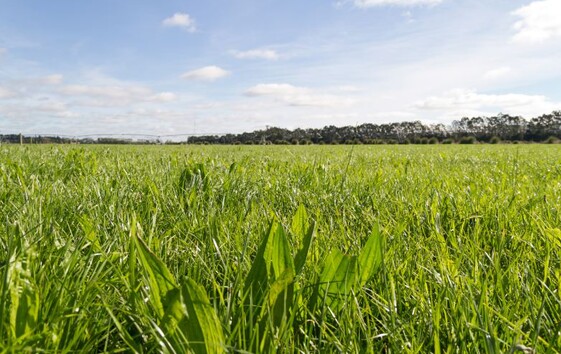A plantain that started life as a common weed has now been shown to have the ability to significantly reduce nitrogen leaching from the urine patch.
Proprietary seed company Agricom has bred the specific plantain genotype and says with New Zealand’s national herd number of 6.5 million dairy cattle, the breakthrough could have a significant impact on reducing nitrogen leaching from dairy farms.
The urine patch is an area that holds a concentrated amount of nitrogen from animal urine. Most nitrogen leaching from animal farms comes from the urine patch.
Agricom has been working alongside researchers at Lincoln and Massey universities and Plant & Food Research to discover how this unique genotype of plantain, called Ecotain, can function in pasture systems to reduce nitrogen leaching.
The plantain, officially deemed a herb, began life as a common flat weed (Plantago lanceloata) which Agricom bred and commercialised into a successful forage cultivar. The resulting plantain, Ecotain, is part of Agricom’s nitrogen management system NSentinel4, and works across a variety of environmental processes on-farm to decrease nitrogen leaching from the urine patch.
Agricom New Zealand sales and marketing manager Mark Brown says the NSentinel4 nitrogen management system and Ecotain has huge potential for reducing the amount of nitrogen in our environment.
“New Zealanders are well-versed on the issue of nitrogen leaching and the negative effects it has on the environment.
“Ecotain is a simple and effective tool to help combat the incredibly complex issue of nitrogen leaching, and it’s a solution that has been developed by industry, for industry.”
The announcement of the research around Ecotain takes place at an event in Christchurch on Thursday 14 September.
Agricom science lead Dr Glenn Judson says while plantain isn’t a new forage product (it has been used by farmers for many years), research now shows that using this specific genotype effectively can result in a significant reduction in nitrogen leaching from the urine patch.
“Depending on the factors at play on farm and the extent to which Ecotain is used, the reduction in nitrogen leaching is very significant,” he says. “In one of the research programmes, where Ecotain is used in what is likely the optimal way, there was a reduction in nitrogen leaching by as much as 89 per cent from the urine patch.”
Ecotain can be used in pasture in a number of ways: as a special purpose crop where Ecotain, and often clover, are the only seeds sown, or in a grass/clover/Ecotain mixed pasture system. It can also be oversown into existing pasture. A pure sward of Ecotain is favoured for its high summer yield and cool season activity, suited to dairy farms where the amount and quality of summer pasture often limits milk production.
Ecotain is highly complementary in a mixed pasture system, providing a good balance of seasonal production and summer quality, as well as being an excellent source of micronutrients such as copper and selenium.
Dr Judson says sheep and beef farmers are currently the predominant users of the plantain, which receives favourable reports due to its good agronomic performance. While dairy farmers are more familiar with the use of chicory on farms, due to its high feed value and resilience to dry periods, the potential of Ecotain on dairy farms is significant and the results from research so far have been impressive.
“We know that the urine patch is the greatest source of leached nitrogen. You have a cow, for example, grazing across a large area of pasture, about 140 square metres per day. When they urinate, they’re depositing a high concentration of nitrogen into a very small area compared to the size they were grazing, and that small area is the urine patch.
“The plants and soil surrounding the urine patch can’t absorb all that nitrogen, so it’s easily leached away below the root zone and also into the water table. Research is showing us that controlling the nitrogen in the urine patch is the most practical way of reducing nitrogen leaching on-farm.”
Ecotain reduces nitrogen leaching from the urine patch in four ways: it increases the volume of cows’ urine which dilutes the concentration of nitrogen, it reduces the total amount of nitrogen in animals’ urine, it delays the process of turning ammonium into nitrate in the urine patch, and it restricts the accumulation of nitrate in Ecotain-growing soil. In the NSentinel 4 nitrogen management system, these four mechanisms of activity are referred to as dilute, reduce, delay, restrict.
The research
With Callaghan Innovation funding, Agricom developed the Greener Pastures Project in 2015, which combines research and expertise from Massey and Lincoln universities and Plant and Food Research. In parallel with the DairyNZ-led Forages for Reduced Nitrogen Leaching (FRNL) programme, the Greener Pastures Project has a comprehensive series of peer-reviewed scientific papers to support the NSentinel4 concept and Ecotain.
Based on overall research findings, Ecotain has been proven to facilitate a sustained diuretic effect in livestock, reduce the concentration of nitrogen in urine, slow the nitrification process in the urine patch and restrict the accumulation of nitrate in Ecotain-growing soil.
Researchers from Lincoln University contributed to the dilute mechanism of Ecotain. Alongside Agricom’s technical team, their work looked at diuretics in sheep, proving the relationship between animals eating Ecotain and the resulting increased urinary function.
Grant Edwards, Lincoln University’s professor of dairy production, says the research indicates that feeding Ecotain to livestock may reduce the concentration of nitrogen in the urine and the nitrogen loading in the urine patch.
“Because the urine patch is the primary source of nitrogen losses, the research highlights the great potential of using plantain as a strategy to reduce nitrogen losses from livestock grazing systems.”
Massey University researchers pioneered some of the techniques for secondary plant compound analysis. They carried out research on their No 4 dairy farm in Palmerston North and found naturally occurring bioactive compounds in Ecotain that improved nitrogen partitioning in dairy cows.
Head of Massey University’s Institute of Agriculture and Environment Professor Peter Kemp says it’s exciting to be part of breakthrough research like this.
“We’re continuing to research the ways the bioactives in Ecotain decrease nitrogen losses from dairy pastures,” he says. “Helping farmers obtain a substantial decrease in nitrate leaching, while maintaining milk production by including Ecotain in their pastures, is a contribution to sustainable farming we’re proud to be associated with.”
Plant & Food Research’s soil science expertise contributed to an understanding of how urine behaves when it reaches the soil surface, and how urine from Ecotain-fed animals differs from pasture-fed animals.
Collaboration
DairyNZ, New Zealand’s dairy farmer representative body, has carried out work with plantain as part of its Pastoral21 and FRNL programmes. Both programmes aim to reduce nitrate leaching losses by 20-30 per cent by delivering proven, adoptable, and profitable pasture and forage crop options. This work has been in addition to Agricom’s research.
Bruce Thorrold, strategy and investment leader for productivity at DairyNZ, says the research has two messages in relation to plantain. First, plantain cultivars with the right composition show clear potential to reduce nitrogen leaching from pastoral farms. Second, it’s likely that not all plantains are equally effective in nitrogen management.
“This is an important and exciting finding,” Mr Thorrold says. “It means that we can add effective plantain cultivars to the range of options we are building for farmers to reduce nutrient loss. Agricom have assembled a significant data set that supports the potential of Ecotain in helping reduce leaching losses.
“There is still a lot to be learnt before we can be confident in predicting the farm scale impact of different plantains across New Zealand, and experience has taught us that it is important to test new innovations in whole systems, across several years and under different soil types and climates.
“We will be working with Agricom to ensure this research is done and available to all farmers.”
Ngāi Tahu Farming, one of the largest farming organisations in Te Wai Pounamou (the South Island), already uses Ecotain across its Te Whenua Hou and Balmoral farms. Ngāi Tahu Farming manages over 100,000 hectares of farming and forestry assets, including approximately 7500 hectares of irrigated and dryland pasture in Canterbury.
“Our value of kaitiakitanga means we take an inter-generational approach to our use of the land and the continual improvement of environmental outcomes is of the utmost importance to our farming operations,” says Ngāi Tahu Farming chief executive Andrew Priest.
“Using Ecotain supports our values and we’re pleased to be able to share our experience for the benefit of the wider farming industry.”
Dr Judson says Agricom has also been working closely with regional councils to keep them updated on NSentinel4 and Ecotain’s progress. “We’ve had excellent feedback from everyone we’ve talked to so far, and we’ll be meeting with more regional councils and other stakeholders as time goes on.”

